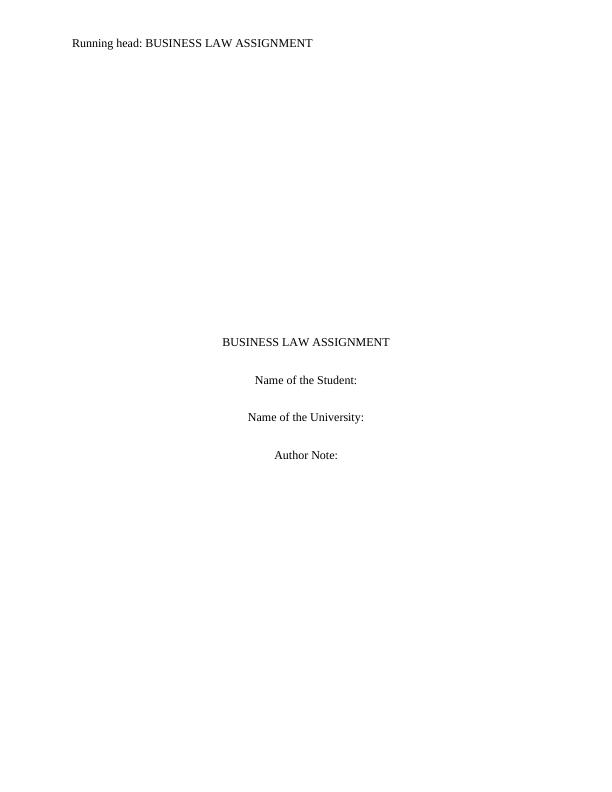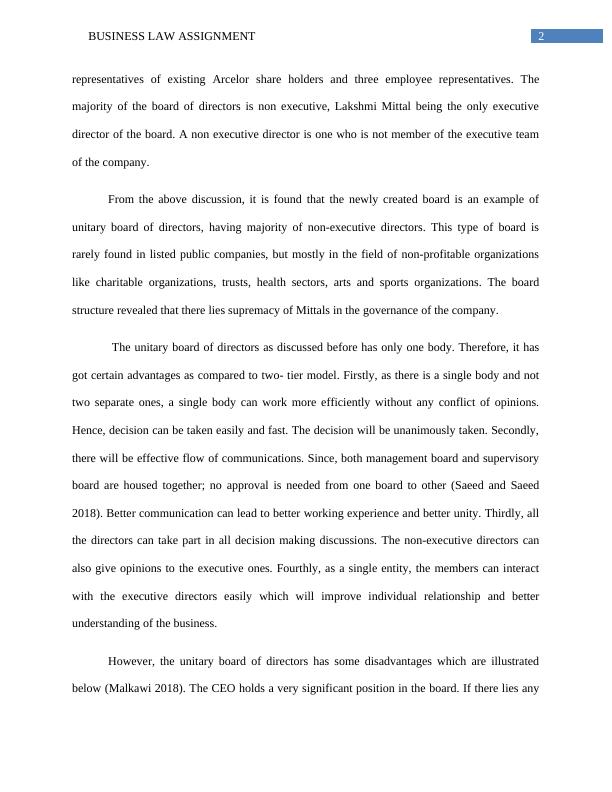Board Structure after the Merging of Arcelor and Mittal in 2006
Added on 2023-04-25
10 Pages2737 Words424 Views
Running head: BUSINESS LAW ASSIGNMENT
BUSINESS LAW ASSIGNMENT
Name of the Student:
Name of the University:
Author Note:
BUSINESS LAW ASSIGNMENT
Name of the Student:
Name of the University:
Author Note:

1BUSINESS LAW ASSIGNMENT
Answer 1:
The case study deals with the merging of Arcelor and Mittal in the year 2006 (Zarin and
Yang 2011). ArcelorMittal is the descendant of Mittal Steel, a business that was established in
the year of 1976 by Mr. Lakshmi N Mittal. The ArcelorMittal was incorporated in 2006 when
Arcelor and Mittal Steel merged together. It was a hostile takeover by the Mittals that however,
resulted into the world’s biggest steel plant. Mittal had previously a unitary board of directors.
Unitary board means the entire governance of the company is carried out by a single body
(O’Boyle and Shilbury 2016). There is no separate management or supervisory board. Entire
governance is done by a single board. Unitary board is generally of four types; a board of
executive directors only, a board having majority of executive directors, a board having majority
of non-executive directors and a board with only non-executive directors. On the other hand,
Arcelor was incorporated in Luxembourg with two tier board structure. A two-tier board
structure is one that has two subsidiary boards namely management board and supervisory board.
It has got two board of directors, on for each subsidiary board. It is also called dual board
structure. The two sub-boards in a two-tier board work independently (Block and Gerstner
2016).
After the merging of Arcelor and Mittal, the new company ArcelorMittal had a new
board of directors with 18 members, all being non-executive. Out of these, majority of the
members are independent. In the newly formed Arcelor-Mittal, Mittal family however retained
43.5% voting rights. It is a Public Limited Liability governed by its board of directors. The board
of directors works as per the provisions enumerated in the company’s articles of association
(McLaughlin 2018). The new board had six directors from Arcelor, six from Mittal, three current
Answer 1:
The case study deals with the merging of Arcelor and Mittal in the year 2006 (Zarin and
Yang 2011). ArcelorMittal is the descendant of Mittal Steel, a business that was established in
the year of 1976 by Mr. Lakshmi N Mittal. The ArcelorMittal was incorporated in 2006 when
Arcelor and Mittal Steel merged together. It was a hostile takeover by the Mittals that however,
resulted into the world’s biggest steel plant. Mittal had previously a unitary board of directors.
Unitary board means the entire governance of the company is carried out by a single body
(O’Boyle and Shilbury 2016). There is no separate management or supervisory board. Entire
governance is done by a single board. Unitary board is generally of four types; a board of
executive directors only, a board having majority of executive directors, a board having majority
of non-executive directors and a board with only non-executive directors. On the other hand,
Arcelor was incorporated in Luxembourg with two tier board structure. A two-tier board
structure is one that has two subsidiary boards namely management board and supervisory board.
It has got two board of directors, on for each subsidiary board. It is also called dual board
structure. The two sub-boards in a two-tier board work independently (Block and Gerstner
2016).
After the merging of Arcelor and Mittal, the new company ArcelorMittal had a new
board of directors with 18 members, all being non-executive. Out of these, majority of the
members are independent. In the newly formed Arcelor-Mittal, Mittal family however retained
43.5% voting rights. It is a Public Limited Liability governed by its board of directors. The board
of directors works as per the provisions enumerated in the company’s articles of association
(McLaughlin 2018). The new board had six directors from Arcelor, six from Mittal, three current

2BUSINESS LAW ASSIGNMENT
representatives of existing Arcelor share holders and three employee representatives. The
majority of the board of directors is non executive, Lakshmi Mittal being the only executive
director of the board. A non executive director is one who is not member of the executive team
of the company.
From the above discussion, it is found that the newly created board is an example of
unitary board of directors, having majority of non-executive directors. This type of board is
rarely found in listed public companies, but mostly in the field of non-profitable organizations
like charitable organizations, trusts, health sectors, arts and sports organizations. The board
structure revealed that there lies supremacy of Mittals in the governance of the company.
The unitary board of directors as discussed before has only one body. Therefore, it has
got certain advantages as compared to two- tier model. Firstly, as there is a single body and not
two separate ones, a single body can work more efficiently without any conflict of opinions.
Hence, decision can be taken easily and fast. The decision will be unanimously taken. Secondly,
there will be effective flow of communications. Since, both management board and supervisory
board are housed together; no approval is needed from one board to other (Saeed and Saeed
2018). Better communication can lead to better working experience and better unity. Thirdly, all
the directors can take part in all decision making discussions. The non-executive directors can
also give opinions to the executive ones. Fourthly, as a single entity, the members can interact
with the executive directors easily which will improve individual relationship and better
understanding of the business.
However, the unitary board of directors has some disadvantages which are illustrated
below (Malkawi 2018). The CEO holds a very significant position in the board. If there lies any
representatives of existing Arcelor share holders and three employee representatives. The
majority of the board of directors is non executive, Lakshmi Mittal being the only executive
director of the board. A non executive director is one who is not member of the executive team
of the company.
From the above discussion, it is found that the newly created board is an example of
unitary board of directors, having majority of non-executive directors. This type of board is
rarely found in listed public companies, but mostly in the field of non-profitable organizations
like charitable organizations, trusts, health sectors, arts and sports organizations. The board
structure revealed that there lies supremacy of Mittals in the governance of the company.
The unitary board of directors as discussed before has only one body. Therefore, it has
got certain advantages as compared to two- tier model. Firstly, as there is a single body and not
two separate ones, a single body can work more efficiently without any conflict of opinions.
Hence, decision can be taken easily and fast. The decision will be unanimously taken. Secondly,
there will be effective flow of communications. Since, both management board and supervisory
board are housed together; no approval is needed from one board to other (Saeed and Saeed
2018). Better communication can lead to better working experience and better unity. Thirdly, all
the directors can take part in all decision making discussions. The non-executive directors can
also give opinions to the executive ones. Fourthly, as a single entity, the members can interact
with the executive directors easily which will improve individual relationship and better
understanding of the business.
However, the unitary board of directors has some disadvantages which are illustrated
below (Malkawi 2018). The CEO holds a very significant position in the board. If there lies any

End of preview
Want to access all the pages? Upload your documents or become a member.
Related Documents
Corporate Law Assignment: Board Structure of ArcelorMittallg...
|10
|2406
|316
Corporate Governance Question Answer 2022lg...
|11
|3118
|17
Corporate Governance: ArcelorMittal Mergerlg...
|9
|2674
|54
Corporate Governance: Unitary Board vs Two-Tier Board Frameworklg...
|10
|2763
|294
Corporate Governance Answer 2022lg...
|10
|2554
|19
Corporate Administration: Precedence and Drawbacks of the Board Structure after the Arcelor-Mittal Mergerlg...
|10
|2905
|32